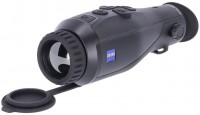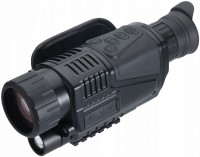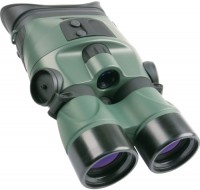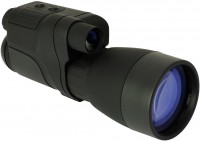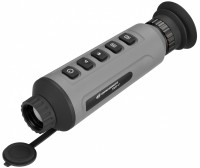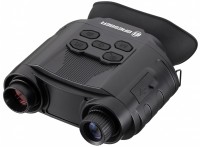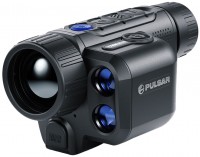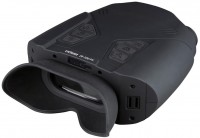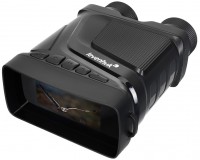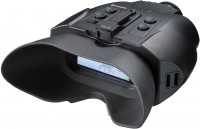NVDs and Thermal Imagers Hikmicro
All models Advanced filters → |
You might be interested in
NVDs and Thermal Imagers: specifications, types
Type
The type in this case determines the general features of the application of the device.
— Night-vision device. Classical night vision devices (NVD) are models that work on the principle of light multiplication — when very weak visible light or invisible infrared radiation is converted into a “picture” bright enough for the human eye. The environment in such devices looks somewhat more natural than in thermal imagers; on the other hand, classical night vision devices do not allow identifying individual objects by temperature difference.
— Thermal imager. The name of this type of devices is due to the fact that they build an image visible to the user based on the temperature of objects in the field of view. The temperature is determined by the intensity of infrared radiation in the so-called middle range, and each value has its own colour. Thus, the observer sees objects in artificial colours (usually black and white, but there may be exceptions) and can assess how hot this or that object or area is. One of the most useful features provided by this is the identification of individual objects by temperature contrast: for example, a warm-blooded animal in a dense bush will be clearly visible in a thermal imager, even if, when viewed through conventional optics or a classic night vision device, it completely merges with the background. It is also worth noting that such devices do not need backlighting and work normally even...in complete darkness. Of the shortcomings, it is worth noting the dependence of the effectiveness of thermal imagers on air temperature (for example, in hot weather, when everything around is heated, warm contrasting objects will be less visible).
— Night-vision device. Classical night vision devices (NVD) are models that work on the principle of light multiplication — when very weak visible light or invisible infrared radiation is converted into a “picture” bright enough for the human eye. The environment in such devices looks somewhat more natural than in thermal imagers; on the other hand, classical night vision devices do not allow identifying individual objects by temperature difference.
— Thermal imager. The name of this type of devices is due to the fact that they build an image visible to the user based on the temperature of objects in the field of view. The temperature is determined by the intensity of infrared radiation in the so-called middle range, and each value has its own colour. Thus, the observer sees objects in artificial colours (usually black and white, but there may be exceptions) and can assess how hot this or that object or area is. One of the most useful features provided by this is the identification of individual objects by temperature contrast: for example, a warm-blooded animal in a dense bush will be clearly visible in a thermal imager, even if, when viewed through conventional optics or a classic night vision device, it completely merges with the background. It is also worth noting that such devices do not need backlighting and work normally even...in complete darkness. Of the shortcomings, it is worth noting the dependence of the effectiveness of thermal imagers on air temperature (for example, in hot weather, when everything around is heated, warm contrasting objects will be less visible).
Form factor
— Binoculars. In its classic form, binoculars require a pair of optical systems, each with its own lens and eyepiece. Thanks to this, you can view objects with both eyes at once, which is quite convenient in itself (you don’t have to close your eyes), and the image looks three-dimensional. The main disadvantage of traditional binoculars compared to monoculars is their higher cost due to their more complex design. Also, such devices are larger, heavier, and if it is impossible to see normally with both eyes at once (for example, with strabismus, or if one eye is missing), all their advantages become irrelevant. At the same time, there is a specific variety - “pseudo-binoculars”: these are night vision devices with one lens, the image from which is sent to two eyepieces. In this case, there is no question of a three-dimensional image, which is why the use of such devices is more limited (in particular, they are considered poorly suitable for driving); but the designs are simpler, lighter and cheaper.
— Monocular. Optical instruments designed for one eye and equipped, respectively, with one optical system with an eyepiece and a lens. They are not as convenient as binoculars because they do not allow for a three-dimensional image and require one eye to be closed. On the other hand, monoculars are much more versatile. Thus, with a slight magnification of such a device, you can observe the situation wit...h both eyes at once, receiving an image from both the NVD and the naked eye; some monoculars can be mounted on weapons, turning a regular sight into a night sight; Another option is to install the device on a helmet and sight through it; and so on. However, the most important advantages over binoculars are compactness, low weight and low cost; In addition, monoculars are suitable even for people with binocular vision disorders.
— Sight. Devices designed for installation on weapons and equipped with appropriate mounts, as well as an aiming reticle of one type or another and a reinforced housing that can withstand recoil. They can be both NVGs and thermal imagers (see “Type”). In fact, such devices are an improved type of optical sights, designed for use in the dark, and in the case of thermal imagers, also in poor visibility conditions (fog, dense vegetation). And some models provide quite advanced functions that make accurate shooting much easier: rangefinder, barometer, compass, ballistic calculator, etc.
- Nozzle. Strictly speaking, this type of optical device is not a night vision device - the attachments themselves do not provide visibility in the dark. In fact, they are additional accessories, the installation of which allows you to expand the capabilities of a full-fledged night vision device. Most attachments play the role of magnetizers - i.e. increase the magnification factor. Such devices are created for specific NVD models, and even from the same manufacturer, not all attachments and devices are mutually compatible; Therefore, you should pay special attention to these points when purchasing.
— Monocular. Optical instruments designed for one eye and equipped, respectively, with one optical system with an eyepiece and a lens. They are not as convenient as binoculars because they do not allow for a three-dimensional image and require one eye to be closed. On the other hand, monoculars are much more versatile. Thus, with a slight magnification of such a device, you can observe the situation wit...h both eyes at once, receiving an image from both the NVD and the naked eye; some monoculars can be mounted on weapons, turning a regular sight into a night sight; Another option is to install the device on a helmet and sight through it; and so on. However, the most important advantages over binoculars are compactness, low weight and low cost; In addition, monoculars are suitable even for people with binocular vision disorders.
— Sight. Devices designed for installation on weapons and equipped with appropriate mounts, as well as an aiming reticle of one type or another and a reinforced housing that can withstand recoil. They can be both NVGs and thermal imagers (see “Type”). In fact, such devices are an improved type of optical sights, designed for use in the dark, and in the case of thermal imagers, also in poor visibility conditions (fog, dense vegetation). And some models provide quite advanced functions that make accurate shooting much easier: rangefinder, barometer, compass, ballistic calculator, etc.
- Nozzle. Strictly speaking, this type of optical device is not a night vision device - the attachments themselves do not provide visibility in the dark. In fact, they are additional accessories, the installation of which allows you to expand the capabilities of a full-fledged night vision device. Most attachments play the role of magnetizers - i.e. increase the magnification factor. Such devices are created for specific NVD models, and even from the same manufacturer, not all attachments and devices are mutually compatible; Therefore, you should pay special attention to these points when purchasing.
Detection range
The greatest distance at which a night vision device is capable of detecting individual objects.
The methods by which manufacturers determine this parameter may vary in detail, but the general principle is the same. Usually, the distance is indicated at which, with an illumination of 0.05 lux (a quarter of the moon) and a medium-contrast background, a rather large object can be seen — for example, a human figure with a height of about 170 cm is most often taken. of this object, but only to notice the very fact of its presence. Simply put, a detection range of, say, 200 m means that “something that looks like a person” can be seen in such a device at a distance of 200 m, but individual parts (head, hands) cannot be disassembled.
It is also worth noting that in fact this parameter is highly dependent on the characteristics of the situation. For example, a dark object on a very light background will be visible further, and on a dark one it may not be noticeable even up close; a similar phenomenon is observed for thermal imagers (see "Type"), only regarding the difference in temperature, and not in colours.
The methods by which manufacturers determine this parameter may vary in detail, but the general principle is the same. Usually, the distance is indicated at which, with an illumination of 0.05 lux (a quarter of the moon) and a medium-contrast background, a rather large object can be seen — for example, a human figure with a height of about 170 cm is most often taken. of this object, but only to notice the very fact of its presence. Simply put, a detection range of, say, 200 m means that “something that looks like a person” can be seen in such a device at a distance of 200 m, but individual parts (head, hands) cannot be disassembled.
It is also worth noting that in fact this parameter is highly dependent on the characteristics of the situation. For example, a dark object on a very light background will be visible further, and on a dark one it may not be noticeable even up close; a similar phenomenon is observed for thermal imagers (see "Type"), only regarding the difference in temperature, and not in colours.
Principle of operation
The principle of operation of the module that provides amplification of visible light. This parameter is indicated only for classic night vision devices (see "Type"), because thermal imagers work on the same principle, and they do not need clarification.
— EOP. Abbreviation for "electronic-optical converter". Also, such night vision devices can be called analogue, as opposed to the digital ones described below. The principle of their operation is as follows: a special electrode (the so-called photocathode) converts a weak light flux or infrared radiation into a stream of electrons in a vacuum tube, and under the influence of these electrons, the screen visible to the user already glows (a similar principle was used in kinescope TVs). At the same time, on the way to the screen, the electrons are accelerated in order to ensure the normal brightness of the visible “picture”. Roughly speaking, the image intensifier tube “pumps” the invisible light flux to the required brightness level. The main advantage of this option is the low cost due to the simplicity of the design; moreover, they can be made quite sensitive. At the same time, most image intensifier tubes do not tolerate bright light well: they are prone to spurious illumination (when a point source of illumination blurs into a large spot, clogging the image around), and when used during the day, such a sight may fail altogether. And there are usually fewer additional functions i...n analogue devices than in digital ones. Note that today there are several generations of image intensifier tubes; the newer the generation, the better, more complex and more expensive the converter. At the same time, the quality of night vision devices as a whole largely depends on other factors, so the “old” or “new” image intensifier tube itself is not an unambiguous indicator.
— Digital. Night vision devices of this type are actually a kind of video cameras: the image falls on a digital matrix (usually of the CCD type), is processed by electronic circuits and displayed on a monitor visible to the user (in this case, a small screen, similar to those used in video camera viewfinders). The possibility of night use is due to the fact that modern CCD matrices are able to respond to very weak light, as well as to infrared radiation, invisible to the human eye. At the same time, such devices can be used without problems during the day, because. daylight does not harm the matrix, and the settings, usually, provide the appropriate mode of operation of the electronics (up to automatic adjustment to brightness). The main disadvantage of digital night vision devices is the high cost due to the complexity of the design.
— EOP. Abbreviation for "electronic-optical converter". Also, such night vision devices can be called analogue, as opposed to the digital ones described below. The principle of their operation is as follows: a special electrode (the so-called photocathode) converts a weak light flux or infrared radiation into a stream of electrons in a vacuum tube, and under the influence of these electrons, the screen visible to the user already glows (a similar principle was used in kinescope TVs). At the same time, on the way to the screen, the electrons are accelerated in order to ensure the normal brightness of the visible “picture”. Roughly speaking, the image intensifier tube “pumps” the invisible light flux to the required brightness level. The main advantage of this option is the low cost due to the simplicity of the design; moreover, they can be made quite sensitive. At the same time, most image intensifier tubes do not tolerate bright light well: they are prone to spurious illumination (when a point source of illumination blurs into a large spot, clogging the image around), and when used during the day, such a sight may fail altogether. And there are usually fewer additional functions i...n analogue devices than in digital ones. Note that today there are several generations of image intensifier tubes; the newer the generation, the better, more complex and more expensive the converter. At the same time, the quality of night vision devices as a whole largely depends on other factors, so the “old” or “new” image intensifier tube itself is not an unambiguous indicator.
— Digital. Night vision devices of this type are actually a kind of video cameras: the image falls on a digital matrix (usually of the CCD type), is processed by electronic circuits and displayed on a monitor visible to the user (in this case, a small screen, similar to those used in video camera viewfinders). The possibility of night use is due to the fact that modern CCD matrices are able to respond to very weak light, as well as to infrared radiation, invisible to the human eye. At the same time, such devices can be used without problems during the day, because. daylight does not harm the matrix, and the settings, usually, provide the appropriate mode of operation of the electronics (up to automatic adjustment to brightness). The main disadvantage of digital night vision devices is the high cost due to the complexity of the design.
EOC generation
The generation of the image intensifier used in the device with the corresponding principle of operation (see above).
— I. The earliest and, accordingly, the least perfect generation of image intensifier tubes presented on the modern market. Allows relatively comfortable use of night vision devices under the condition of fairly bright "night" lighting (for example, on a moonlit night); in weaker light, active IR illumination is required. At the same time, image intensifier tubes of the first generation are inconvenient when working with point light sources — parasitic illumination appears and the light source “blurs” on the screen. And accidental illumination (for example, hitting the light of car headlights) most likely disables such a device: automatic protection against it is extremely rare, and it is not always possible to close or retract the lens in time. In addition, closer to the edges of the field of view, the resolution of the image in such an image intensifier tube noticeably decreases and distortions appear in it (for example, a square may look like a “cushion”). Simplicity and, accordingly, low cost can be called the unambiguous advantages of the first generation devices. The resource of such a converter is on average about 1000 hours, which is quite enough for infrequent "forays" into nature, but not enough for permanent use.
— I+. An improved and modified version of the...I generation image intensifiers described above. The main improvement was the use of the so-called fibre optic plate — thanks to it, it was possible to make the resolution the same throughout the entire field of view, and also to almost completely get rid of distortion. On the other hand, due to some technical features, such night vision devices at the same magnification turn out to be more expensive (sometimes several times) and bulkier than their predecessors, and they have no advantages over them, in addition to those described above. Because of this, the improved version of the first generation image intensifier is less common than the original.
— II. The key difference between the second generation image intensifier tube and its predecessors was a two-stage light amplification scheme: in the traditional way, as in the first generation, and then using a microchannel plate. This made it possible to significantly increase the degree of amplification, which made it possible to use night vision devices even on a dark night — by the light of stars in light clouds. In this generation, it was also possible to ensure uniform image quality over the entire field of view, to get rid of significant spurious flare (a point light source in the field of view almost does not blur). In addition, automatic protection against backlight has become almost mandatory for such devices, and the resource, compared to the first generation, has increased significantly — up to 3000 hours in some models. However the cost of night vision devices with such converters has increased significantly.
— II+. Improvement of the second generation transducers (see above), aimed, in particular, at reducing the size of night vision devices and further improving the quality of the "picture" (albeit at the expense of some reduction in the light amplification factor). Note that under this designation, both the “original” generation II + and its improved version Super Gen II + can be hidden. The latter option is able to provide a visibility range almost at the level of the image intensifier tube of the III generation, and at the same time it costs much less (although still more expensive than the device of the original generation II +).
— III. In the third generation of image intensifier tubes, manufacturers used an innovative material in the design of the photocathode, which made it possible to significantly increase the sensitivity (both general and in the IR range). Converters of this generation are capable of operating in extremely low light, provide a clear, high-quality image with high detail and have a resource of about 10,000 hours; thus, they are the most advanced on the modern civilian market. However, the main users of such equipment are the military and representatives of special services: it is for them that the described advantages are critically important, and III generation image intensifier tubes cost 1.5 – 2 times more expensive than II + (which are not cheap in themselves), which makes it difficult for civilians to use such devices. Another disadvantage of converters of this type is considered to be a rather significant sensitivity to side illumination.
— I. The earliest and, accordingly, the least perfect generation of image intensifier tubes presented on the modern market. Allows relatively comfortable use of night vision devices under the condition of fairly bright "night" lighting (for example, on a moonlit night); in weaker light, active IR illumination is required. At the same time, image intensifier tubes of the first generation are inconvenient when working with point light sources — parasitic illumination appears and the light source “blurs” on the screen. And accidental illumination (for example, hitting the light of car headlights) most likely disables such a device: automatic protection against it is extremely rare, and it is not always possible to close or retract the lens in time. In addition, closer to the edges of the field of view, the resolution of the image in such an image intensifier tube noticeably decreases and distortions appear in it (for example, a square may look like a “cushion”). Simplicity and, accordingly, low cost can be called the unambiguous advantages of the first generation devices. The resource of such a converter is on average about 1000 hours, which is quite enough for infrequent "forays" into nature, but not enough for permanent use.
— I+. An improved and modified version of the...I generation image intensifiers described above. The main improvement was the use of the so-called fibre optic plate — thanks to it, it was possible to make the resolution the same throughout the entire field of view, and also to almost completely get rid of distortion. On the other hand, due to some technical features, such night vision devices at the same magnification turn out to be more expensive (sometimes several times) and bulkier than their predecessors, and they have no advantages over them, in addition to those described above. Because of this, the improved version of the first generation image intensifier is less common than the original.
— II. The key difference between the second generation image intensifier tube and its predecessors was a two-stage light amplification scheme: in the traditional way, as in the first generation, and then using a microchannel plate. This made it possible to significantly increase the degree of amplification, which made it possible to use night vision devices even on a dark night — by the light of stars in light clouds. In this generation, it was also possible to ensure uniform image quality over the entire field of view, to get rid of significant spurious flare (a point light source in the field of view almost does not blur). In addition, automatic protection against backlight has become almost mandatory for such devices, and the resource, compared to the first generation, has increased significantly — up to 3000 hours in some models. However the cost of night vision devices with such converters has increased significantly.
— II+. Improvement of the second generation transducers (see above), aimed, in particular, at reducing the size of night vision devices and further improving the quality of the "picture" (albeit at the expense of some reduction in the light amplification factor). Note that under this designation, both the “original” generation II + and its improved version Super Gen II + can be hidden. The latter option is able to provide a visibility range almost at the level of the image intensifier tube of the III generation, and at the same time it costs much less (although still more expensive than the device of the original generation II +).
— III. In the third generation of image intensifier tubes, manufacturers used an innovative material in the design of the photocathode, which made it possible to significantly increase the sensitivity (both general and in the IR range). Converters of this generation are capable of operating in extremely low light, provide a clear, high-quality image with high detail and have a resource of about 10,000 hours; thus, they are the most advanced on the modern civilian market. However, the main users of such equipment are the military and representatives of special services: it is for them that the described advantages are critically important, and III generation image intensifier tubes cost 1.5 – 2 times more expensive than II + (which are not cheap in themselves), which makes it difficult for civilians to use such devices. Another disadvantage of converters of this type is considered to be a rather significant sensitivity to side illumination.
Optical magnification
The degree of image magnification that a night vision device is able to provide without digital image processing, solely due to the optical system. Such an increase is considered to be preferable to digital, because. it does not impair the clarity of the visible image; and for models based on image intensifier tubes (see "How it works"), this is generally the only available option.
Theoretically, the higher the magnification, the greater the detection range (see above), since a powerful increase allows you to see smaller objects. However, it does not always make sense to chase the maximum performance. The fact is that with increasing magnification, the angular field of view decreases and the minimum focus distance increases (see both below), which can create problems at close range. It is also worth noting that a high degree of magnification adversely affects the luminosity of the entire system — as a result, the actual detection range in complete darkness may be higher for a device with a lower magnification, because. it "catches" more light. Yes, and this parameter affects the cost accordingly.
Note that night vision devices, unlike classical binoculars and monoculars, most often have a fixed magnification. Models with the possibility of smooth adjustment are almost never found, and the only option is to use additional nozzles (see "Form factor").
Now on the market are night vision devices with the following optical zoom: 1x, 2 – 3x, 3.1 – 4x, > 4x
Theoretically, the higher the magnification, the greater the detection range (see above), since a powerful increase allows you to see smaller objects. However, it does not always make sense to chase the maximum performance. The fact is that with increasing magnification, the angular field of view decreases and the minimum focus distance increases (see both below), which can create problems at close range. It is also worth noting that a high degree of magnification adversely affects the luminosity of the entire system — as a result, the actual detection range in complete darkness may be higher for a device with a lower magnification, because. it "catches" more light. Yes, and this parameter affects the cost accordingly.
Note that night vision devices, unlike classical binoculars and monoculars, most often have a fixed magnification. Models with the possibility of smooth adjustment are almost never found, and the only option is to use additional nozzles (see "Form factor").
Now on the market are night vision devices with the following optical zoom: 1x, 2 – 3x, 3.1 – 4x, > 4x
Continuous zoom
The ability to adjust the degree of magnification within a certain range, allowing you to adapt the night vision device to different conditions and situations. Thus, when observing over long distances, it is optimal to use a higher magnification to obtain a detailed image. And when moving or observing in low visibility conditions, zooming out may be preferable to expand the field of view. Night vision devices with variable optical magnification are universal and adaptable tools, however, such a function is extremely rare - most often NVGs have a fixed magnification (see “Optical magnification”).
Digital magnification
The maximum magnification that a night vision device can achieve through digital image processing.
This function is available only in thermal imagers and some digital models of classic night vision devices (see "How it works"). In general terms, it can be described as follows: the device electronics takes part of the image from the NVD receiver and “stretches” it to the entire frame visible to the user, due to which objects in the field of view look larger. At the same time, this procedure reduces the clarity of the visible image. Therefore, models with digital zoom are quite rare, and even in such cases it plays an auxiliary role and has a very limited magnification — usually less than 2x.
This function is available only in thermal imagers and some digital models of classic night vision devices (see "How it works"). In general terms, it can be described as follows: the device electronics takes part of the image from the NVD receiver and “stretches” it to the entire frame visible to the user, due to which objects in the field of view look larger. At the same time, this procedure reduces the clarity of the visible image. Therefore, models with digital zoom are quite rare, and even in such cases it plays an auxiliary role and has a very limited magnification — usually less than 2x.
Lens diameter
The diameter of the entrance lens that the lens of the night vision device is equipped with.
This parameter is one of the most important for any optical device, including night vision devices: the larger the lens, the more light (or infrared radiation) enters it and the more sensitive the optics are, all other things being equal. The downside of this is an increase in the size, weight and cost of the device. In addition, do not forget that various tricks and additional technologies can be used in the design; therefore, by itself, a large lens is far from always an unambiguous indicator of a high class.
This parameter is one of the most important for any optical device, including night vision devices: the larger the lens, the more light (or infrared radiation) enters it and the more sensitive the optics are, all other things being equal. The downside of this is an increase in the size, weight and cost of the device. In addition, do not forget that various tricks and additional technologies can be used in the design; therefore, by itself, a large lens is far from always an unambiguous indicator of a high class.
Focal length
The focal length of a night vision device. This term means such a distance from the optical centre of the lens to the photocathode of the image intensifier tube or the matrix of a digital device(see "Operation principle"), at which a clear image is obtained on the photocathode/matrix.
In general, long focal lengths are characteristic of optical systems with a high degree of optical magnification (see above). However, in the case of night vision devices, this dependence is not rigid — it is simply easier to ensure a high magnification with long-focus optics. In fact, this means that models with the same focal length can differ markedly in magnification. But what this indicator directly affects is light transmission: other things being equal, longer optical systems transmit less light, which negatively affects the capabilities of the device. This is also true for thermal imagers (see "Type"), because their working infrared range in this case also obeys the general laws of optics.
In general, long focal lengths are characteristic of optical systems with a high degree of optical magnification (see above). However, in the case of night vision devices, this dependence is not rigid — it is simply easier to ensure a high magnification with long-focus optics. In fact, this means that models with the same focal length can differ markedly in magnification. But what this indicator directly affects is light transmission: other things being equal, longer optical systems transmit less light, which negatively affects the capabilities of the device. This is also true for thermal imagers (see "Type"), because their working infrared range in this case also obeys the general laws of optics.
Receiver resolution
Resolution of the matrix installed in the thermal imager (see "Type") or digital night vision device (see "Operation principle"). Usually indicated in pixels horizontally and vertically, for example 640x480.
On the one hand, the higher the resolution, the clearer and more detailed the image will be. On the other hand, increasing the resolution without changing the size of the matrix means that less light will fall on each pixel — and this negatively affects the detection range (see above) and leads to the appearance of noise. Therefore, the resolution of receivers in modern night vision devices is small — in terms of the usual megapixels, it rarely exceeds 0.3 megapixels. And it hardly makes sense to unambiguously compare different models in terms of this parameter — after all, the actual quality of work also largely depends on the size of the receiver, signal processing features, etc.
On the one hand, the higher the resolution, the clearer and more detailed the image will be. On the other hand, increasing the resolution without changing the size of the matrix means that less light will fall on each pixel — and this negatively affects the detection range (see above) and leads to the appearance of noise. Therefore, the resolution of receivers in modern night vision devices is small — in terms of the usual megapixels, it rarely exceeds 0.3 megapixels. And it hardly makes sense to unambiguously compare different models in terms of this parameter — after all, the actual quality of work also largely depends on the size of the receiver, signal processing features, etc.
Refresh rate
The frame rate on the screen of the thermal imager (more precisely, on the display visible to the shooter through the eyepiece). The higher this frequency — the smoother and less jerky the image is, the better the thermal imager is suitable for looking at fast moving objects. On the other hand, this indicator directly affects the price of the device and reduces its battery life, because. a high frame rate requires a powerful (and therefore expensive and high consumption) electronic hardware.
Resolution
The resolution of the visible image created by the night vision device. Indicated by the number of lines (strokes) per millimetre; the higher this indicator, the more detailed the image is capable of creating the night vision device, the better small details will be visible on it. However such devices will cost accordingly.
In models with an image intensifier tube (see "How it works"), the resolution is highly dependent on the generation of the transducer.
In models with an image intensifier tube (see "How it works"), the resolution is highly dependent on the generation of the transducer.
Field of view at 100 m
The size of the area visible in the night vision device from a distance of 100 m — in other words, the largest distance between two points at which they can be seen simultaneously from this distance. It is also called "linear field of view". Along with the angular field of view (see below), this parameter characterizes the space covered by the optics; at the same time, it more clearly describes the capabilities of a particular model than data on viewing angles.
Angular field of view
The angle of view provided by a night vision device — that is, the angle between the lines connecting the observer's eye with the two extreme points of visible space. Wide viewing angles allow you to cover a large area, but the magnification factor (see above) is low; in turn, increasing the magnification leads to a decrease in the field of view.
Min. focus distance
The smallest distance to the observed object, at which it will be clearly visible through the night vision device. For normal use of night vision devices, it is necessary that this distance does not exceed the minimum expected distance to the objects in question; thus, it must be borne in mind that the higher the magnification factor (see above), the greater the focus distance, usually.
Exit pupil diameter
The diameter of the exit pupil created by the optical system of a night vision device. The exit pupil is called the projection of the front lens of the lens, built by optics and electronics in the region of the eyepiece; this image can be observed in the form of a characteristic light circle, if you look into the eyepiece not close, but from a distance of 30 – 40 cm.
The practical significance of this parameter is that for normal visibility it must be no less than the size of the pupil of a person looking into the eyepiece. The diameter of the human pupil can vary from 2-3 mm in bright light to 7-8 mm in the dark. Therefore, the larger the size of the exit pupil of the night vision device, the better the visibility, usually; this is especially true with a minimum amount of light, when the brightness of the image is low even when viewed through the device. On the other hand, this feature significantly affects the cost of the device.
The practical significance of this parameter is that for normal visibility it must be no less than the size of the pupil of a person looking into the eyepiece. The diameter of the human pupil can vary from 2-3 mm in bright light to 7-8 mm in the dark. Therefore, the larger the size of the exit pupil of the night vision device, the better the visibility, usually; this is especially true with a minimum amount of light, when the brightness of the image is low even when viewed through the device. On the other hand, this feature significantly affects the cost of the device.
Offset of the exit pupil
The offset is the distance between the eyepiece lens and the exit pupil of an optical instrument (see "Exit Pupil Diameter"). Optimum image quality is achieved when the exit pupil is projected directly into the observer's eye; so from a practical point of view, offset is the distance from the eye to the eyepiece lens that provides the best visibility and does not darken the edges (vignetting). A large offset is especially important if the night vision device is supposed to be used simultaneously with glasses — after all, in such cases it is not possible to bring the eyepiece close to the eye. It is also relevant for devices that can be installed on a weapon: the greater the distance to the eye, the less likely it is to get injured due to recoil.
Diopter adjustment
Availability of dioptric correction function in NVDs.
This function will be very useful for those who wear glasses due to myopia or farsightedness. By setting the required number of “plus” or “minus” diopters on the adjustment scale, such a customer will be able to look into the eyepiece with the naked eye and see a clear picture - the necessary correction will be provided by the optics of the device. This is much more convenient than watching through glasses.
Note that the correction range is usually small, and in case of serious visual impairments, the capabilities of the optics may not be enough; but such situations are still quite rare.
This function will be very useful for those who wear glasses due to myopia or farsightedness. By setting the required number of “plus” or “minus” diopters on the adjustment scale, such a customer will be able to look into the eyepiece with the naked eye and see a clear picture - the necessary correction will be provided by the optics of the device. This is much more convenient than watching through glasses.
Note that the correction range is usually small, and in case of serious visual impairments, the capabilities of the optics may not be enough; but such situations are still quite rare.
Built-in IR illuminator
The presence of a built-in IR illuminator in the design of the night vision device.
The IR illuminator plays the same role for night vision devices as a regular lamp for the human eye: it provides additional illumination of the visible space, increasing the brightness of the image in the working range of the device. Thanks to this, the device can work normally even in complete darkness, when there is practically no visible light, and infrared radiation from surrounding objects is not enough for normal visibility. At the same time, such illumination is invisible to the naked eye (unless the illuminator itself can stand out; for more details, see "Invisible radiation spectrum"). Of course, the illuminator requires energy to operate; in addition, this function can significantly affect the cost of the device.
The IR illuminator plays the same role for night vision devices as a regular lamp for the human eye: it provides additional illumination of the visible space, increasing the brightness of the image in the working range of the device. Thanks to this, the device can work normally even in complete darkness, when there is practically no visible light, and infrared radiation from surrounding objects is not enough for normal visibility. At the same time, such illumination is invisible to the naked eye (unless the illuminator itself can stand out; for more details, see "Invisible radiation spectrum"). Of course, the illuminator requires energy to operate; in addition, this function can significantly affect the cost of the device.
Wavelength
The wavelength of infrared radiation emitted by the IR illuminator installed in the night vision device. In most cases, this parameter is purely reference: manufacturers usually select the wavelength in such a way that it best suits the features of the device and provides the claimed characteristics. Nevertheless, a practical moment is also associated with the wavelength — the "visibility" or "invisibility" of the illuminator (see "Invisible radiation spectrum").
Invisible emitter spectrum
The presence in the design of night vision devices of an IR emitter(see above), operating in a completely invisible spectrum.
One of the features of modern lighting devices (including infrared ones) is that none of them is capable of producing waves of exactly the same wavelength — some part of the radiation will inevitably capture neighboring ranges. Because of this, situations arise when the illuminator, the main power of which is concentrated in the IR spectrum, also emits visible light. It looks like a dim red glow; it is not strong enough to illuminate surrounding objects to the naked eye, but is clearly visible in the dark and can unmask the user. Radiators with an invisible spectrum, as the name implies, do not have this drawback. Therefore, if you are looking for night vision devices for situations in which stealth is important — for example, for hunting — it makes sense to choose among models with this function. However note that the illumination range of such emitters is somewhat less than that of visible ones.
Usually, "invisible" emitters have a wavelength (see above) of at least 800 nm.
One of the features of modern lighting devices (including infrared ones) is that none of them is capable of producing waves of exactly the same wavelength — some part of the radiation will inevitably capture neighboring ranges. Because of this, situations arise when the illuminator, the main power of which is concentrated in the IR spectrum, also emits visible light. It looks like a dim red glow; it is not strong enough to illuminate surrounding objects to the naked eye, but is clearly visible in the dark and can unmask the user. Radiators with an invisible spectrum, as the name implies, do not have this drawback. Therefore, if you are looking for night vision devices for situations in which stealth is important — for example, for hunting — it makes sense to choose among models with this function. However note that the illumination range of such emitters is somewhat less than that of visible ones.
Usually, "invisible" emitters have a wavelength (see above) of at least 800 nm.
More features
— Video output. The presence in the NVD design of an output that allows you to broadcast an image from the device to an external device — for example, a laptop. Thus, you can view the "picture" on a large display and record video even if the night vision device does not have its own video recorder (see below); and if it is available, you can broadcast not only the image in real time, but also the captured materials. The specific video output interface may vary, but most often the signal is transmitted in analogue format.
— Built-in video recorder. The presence of its own video recorder in the design of night vision devices. This allows you to use the device as a video camera, capturing everything that falls into the field of view on video; at the same time, such recording does not require additional equipment, in contrast to working with the video output described above. Video, usually, is stored on a memory card, and in many models it is possible to view the recording directly on the device itself.
— Switching observation modes. The ability to switch observation modes means changing the colour features in the “picture” visible to the user. So, thermal imagers (see "Type") with this function support at least two classic modes "white hot" (the warmer the object, the brighter it is) and "black hot" (the warmer, the darker); in addition, additional format...s can be provided, such as highlighting especially warm objects in red. In classic night vision devices, switching modes usually involves changing the colour tone of the visible image — for example, from classic green to red or black and white. And additional features may include, for example, a high contrast mode.
— Filling with gas. This feature implies the presence in the body of a filler in the form of an inert gas — for example, nitrogen — containing a minimum of water vapor. Such an environment does not oxidize the parts in contact with it, and the “dryness” of the filler also prevents fogging of the optics from the inside during temperature changes. Note that a kind of “side effect” of filling with gas is dust and water protection (see below), since the cases of such devices, by definition, must be airtight.
— Dust-, water protection. The presence in the design of night vision protection against dust and moisture, which prevents the ingress of contaminants on sensitive components. This feature is almost mandatory if you plan to actively use the device in the open air — for example, hunting. Note that the level of security can be different, and a high degree of protection usually means a high price. Therefore, when choosing, it makes sense to clarify the parameters claimed for each specific model and correlate them with your real needs.
— Impact protection. This function involves the use of various means — strong elastic body materials, shock absorption systems, etc. — which prevent damage to the sensitive components of the device during shock and shock. The degree and features of shock protection can vary markedly: usually, such models can withstand drops of at least 1.5 m, but in some cases this figure may be more. Note that for installation on firearms, special protection against recoil is required, which not all shock-resistant devices have.
— Angled eyecups. The presence of beveled eyecups (or one eyecup, in the case of monoculars — see "Type") in the design of night vision devices. The elongated part of the eyecup when working with the device is located on the outside of the eye, almost on the temple; due to this, it provides additional protection for the eye — primarily from extraneous "flare" that interferes with normal viewing of the image in the eyepiece. At the same time, such models do not go well with glasses: at best, the eyecup will have to be turned up, negating all its advantages, and in some devices this is not even possible.
— Built-in video recorder. The presence of its own video recorder in the design of night vision devices. This allows you to use the device as a video camera, capturing everything that falls into the field of view on video; at the same time, such recording does not require additional equipment, in contrast to working with the video output described above. Video, usually, is stored on a memory card, and in many models it is possible to view the recording directly on the device itself.
— Switching observation modes. The ability to switch observation modes means changing the colour features in the “picture” visible to the user. So, thermal imagers (see "Type") with this function support at least two classic modes "white hot" (the warmer the object, the brighter it is) and "black hot" (the warmer, the darker); in addition, additional format...s can be provided, such as highlighting especially warm objects in red. In classic night vision devices, switching modes usually involves changing the colour tone of the visible image — for example, from classic green to red or black and white. And additional features may include, for example, a high contrast mode.
— Filling with gas. This feature implies the presence in the body of a filler in the form of an inert gas — for example, nitrogen — containing a minimum of water vapor. Such an environment does not oxidize the parts in contact with it, and the “dryness” of the filler also prevents fogging of the optics from the inside during temperature changes. Note that a kind of “side effect” of filling with gas is dust and water protection (see below), since the cases of such devices, by definition, must be airtight.
— Dust-, water protection. The presence in the design of night vision protection against dust and moisture, which prevents the ingress of contaminants on sensitive components. This feature is almost mandatory if you plan to actively use the device in the open air — for example, hunting. Note that the level of security can be different, and a high degree of protection usually means a high price. Therefore, when choosing, it makes sense to clarify the parameters claimed for each specific model and correlate them with your real needs.
— Impact protection. This function involves the use of various means — strong elastic body materials, shock absorption systems, etc. — which prevent damage to the sensitive components of the device during shock and shock. The degree and features of shock protection can vary markedly: usually, such models can withstand drops of at least 1.5 m, but in some cases this figure may be more. Note that for installation on firearms, special protection against recoil is required, which not all shock-resistant devices have.
— Angled eyecups. The presence of beveled eyecups (or one eyecup, in the case of monoculars — see "Type") in the design of night vision devices. The elongated part of the eyecup when working with the device is located on the outside of the eye, almost on the temple; due to this, it provides additional protection for the eye — primarily from extraneous "flare" that interferes with normal viewing of the image in the eyepiece. At the same time, such models do not go well with glasses: at best, the eyecup will have to be turned up, negating all its advantages, and in some devices this is not even possible.
Helmet-mask included
The presence of a helmet-mask in the delivery set of the night vision device.
The helmet-mask is a hoop with a system of belts and a mount for the device. This design allows you to wear night vision devices on your head, due to which your hands remain free when working with the device. At the same time, the thickness of the hoop and belts is usually small, which allows them to be worn under a headdress.
It should be noted that the possibility of installation on a helmet-mask is found in many NVG models, however, the helmet-mask itself is far from always supplied in the kit. Buying it together with the device is much easier than picking it up separately.
The helmet-mask is a hoop with a system of belts and a mount for the device. This design allows you to wear night vision devices on your head, due to which your hands remain free when working with the device. At the same time, the thickness of the hoop and belts is usually small, which allows them to be worn under a headdress.
It should be noted that the possibility of installation on a helmet-mask is found in many NVG models, however, the helmet-mask itself is far from always supplied in the kit. Buying it together with the device is much easier than picking it up separately.
Power source
The type of batteries used by the night vision device for operation. Technically, these can be both replaceable elements of a standard size and built-in batteries. However, in fact, the second option is practically not found, because. it does not make it possible to quickly replace a dead battery with a fresh one — and this possibility is critical for most NVD applications.
As for specific types of batteries, the most common options are:
— CR123. The element that has received the greatest distribution among modern night vision devices. These batteries are similar in shape to the popular AA batteries (see below), but their diameter is larger, and their length is noticeably smaller: 17 and 35 mm, respectively. The operating voltage is 3.7 V, which provides good power, sufficient for normal NVD operation. This led to the popularity of CR123.
— AA. Classic 1.5 V finger batteries. The power of such a power supply is lower than that of CR123, which requires more cells; on the other hand, such batteries are easier to find commercially.
— AAA. "Mini finger" or "little finger" batteries, a smaller version of AA cells. Due to their small size, such elements do not differ in power and capacity, and therefore are used only in relatively simple devices for which compact dimensions are important.
As for specific types of batteries, the most common options are:
— CR123. The element that has received the greatest distribution among modern night vision devices. These batteries are similar in shape to the popular AA batteries (see below), but their diameter is larger, and their length is noticeably smaller: 17 and 35 mm, respectively. The operating voltage is 3.7 V, which provides good power, sufficient for normal NVD operation. This led to the popularity of CR123.
— AA. Classic 1.5 V finger batteries. The power of such a power supply is lower than that of CR123, which requires more cells; on the other hand, such batteries are easier to find commercially.
— AAA. "Mini finger" or "little finger" batteries, a smaller version of AA cells. Due to their small size, such elements do not differ in power and capacity, and therefore are used only in relatively simple devices for which compact dimensions are important.
Continuous operating time
The longest time that the device is able to work continuously from fresh batteries without replacing / recharging them. It should be taken into account that manufacturers usually indicate this time for perfect conditions: high-quality batteries, low brightness of the visible image, operation without the use of IR illumination, video output and video recorder (if available, see "Additional"), optimal operating temperature (see below) ) etc. Therefore, in fact, the time of continuous operation may well be lower than stated. Nevertheless, this parameter makes it possible to both evaluate the battery life of individual devices and compare them with each other.
Operating temperature range
Ambient air temperature range at which the night vision device will be guaranteed to maintain normal performance. This indicator is very important, given that such devices are most often used outdoors, where the temperature variation can be very large. Of course, when choosing, you should take into account the conditions in which you plan to work with the device — for example, it hardly makes sense to specifically look for a frost-resistant model for hunting in the summer. But in general, the wider the operating range, the higher the overall reliability of the device, the less sensitive it is to adverse climates.
It is worth noting that going beyond operating temperatures does not necessarily lead to instant failure; however, even with the preservation of operability, the probability of failure increases many times, and such cases are not covered by the manufacturer's warranty.
It is worth noting that going beyond operating temperatures does not necessarily lead to instant failure; however, even with the preservation of operability, the probability of failure increases many times, and such cases are not covered by the manufacturer's warranty.
Weight
The total weight of the night vision device in the working position. If a helmet-mask is included in the kit (see above), its weight, usually, is also taken into account.
The large weight of the device makes it inconvenient to use — both when working with hands and when attached to a helmet-mask. On the other hand, with similar characteristics, lighter models will either cost more or have poor quality materials.
The large weight of the device makes it inconvenient to use — both when working with hands and when attached to a helmet-mask. On the other hand, with similar characteristics, lighter models will either cost more or have poor quality materials.

